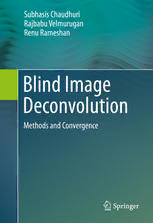Table Of ContentSubhasis Chaudhuri
Rajbabu Velmurugan
Renu Rameshan
Blind Image
Deconvolution
Methods and Convergence
Blind Image Deconvolution
Subhasis Chaudhuri • Rajbabu Velmurugan
Renu Rameshan
Blind Image Deconvolution
Methods and Convergence
123
SubhasisChaudhuri RajbabuVelmurugan
IITBombay,Mumbai IITBombay,Mumbai
Maharashtra,India Maharashtra,India
RenuRameshan
IITBombay,Mumbai
Maharashtra,India
ISBN978-3-319-10484-3 ISBN978-3-319-10485-0(eBook)
DOI10.1007/978-3-319-10485-0
SpringerChamHeidelbergNewYorkDordrechtLondon
LibraryofCongressControlNumber:2014947520
©SpringerInternationalPublishingSwitzerland2014
Thisworkissubjecttocopyright.AllrightsarereservedbythePublisher,whetherthewholeorpartof
thematerialisconcerned,specificallytherightsoftranslation,reprinting,reuseofillustrations,recitation,
broadcasting,reproductiononmicrofilmsorinanyotherphysicalway,andtransmissionorinformation
storageandretrieval,electronicadaptation,computersoftware,orbysimilarordissimilarmethodology
nowknownorhereafterdeveloped.Exemptedfromthislegalreservationarebriefexcerptsinconnection
with reviews or scholarly analysis or material supplied specifically for the purpose of being entered
and executed on a computer system, for exclusive use by the purchaser of the work. Duplication of
this publication or parts thereof is permitted only under the provisions of the Copyright Law of the
Publisher’slocation,initscurrentversion,andpermissionforusemustalwaysbeobtainedfromSpringer.
PermissionsforusemaybeobtainedthroughRightsLinkattheCopyrightClearanceCenter.Violations
areliabletoprosecutionundertherespectiveCopyrightLaw.
Theuseofgeneraldescriptivenames,registerednames,trademarks,servicemarks,etc.inthispublication
doesnotimply,evenintheabsenceofaspecificstatement,thatsuchnamesareexemptfromtherelevant
protectivelawsandregulationsandthereforefreeforgeneraluse.
While the advice and information in this book are believed to be true and accurate at the date of
publication,neithertheauthorsnortheeditorsnorthepublishercanacceptanylegalresponsibilityfor
anyerrorsoromissionsthatmaybemade.Thepublishermakesnowarranty,expressorimplied,with
respecttothematerialcontainedherein.
Printedonacid-freepaper
SpringerispartofSpringerScience+BusinessMedia(www.springer.com)
To
Twoveryspecialrenunciants–KalipadaMaharaj
andSwamiShantananda.
SC.
Karthichitappa.
VRB.
AllfromwhomIhavelearned.
RMR.
Preface
The issue of blur in images has kept researchers in the area of image processing
busyforoverhalfacentury,andtheresearchersattheVisionandImageProcessing
Laboratory,IITBombay,werenoexceptions.Wehavebeenworkinginthisareafor
thelasttwodecades.Earlieroureffortswereconfinedtoinvestigatingthebeneficial
aspects of blur in images wherein we had used defocus blur to estimate depth
in a scene. A monograph entitled Depth from Defocus: A Real Aperture Imaging
Approach, published by the same publisher in 1999, dealt with the problem of
deblurring when there are multiple observations. We derived performance bounds
asafunctionofrelativeblurringamongmultipleobservations.Subsequently,inthe
monographentitled,Motion-FreeSuper-Resolution,againpublishedbySpringerin
2005,wedemonstratedhowtherelativeblurringamongvariousobservationscould
beusedtosuper-resolveanimageveryefficiently.
Inthismonographweinvestigatethedeblurringproblemforasingleobservation.
Thisproblemiswellknowninliteratureasblinddeconvolution,andtherehasbeen
a large volume of work by various researchers as regards how one can perform
deconvolutionwhentheblurisnotknown.Sothequestiondoesarisewhatpurpose
then does this monograph serve? Is this yet another book on image deblurring?
Publicationofthismonographdoesrequireajustification.Areviewofthepublished
literature on blind deconvolution suggests that these works concentrate mostly on
accuracyandefficiencyofvariousproposedalgorithms.
Sinceblinddeconvolutionhasboththepointspreadfunction(PSF)andtheimage
unknown,bothofthemarerequiredtobeestimated.Veryoftenthisrequiressolving
an alternate minimization problem. However, solving an alternate minimization
problem does not always lead to useful solutions. Sometimes it leads to trivial
solutions. It is no wonder that a method proposed by one group does not work
for another group as it requires several parameters to be tweaked. Hence there
is a genuine need for analyzing convergence properties of alternate minimization
methods.Weperformpreciselythesameinthismonographsothattheendusercan
pre-judge the applicability of a given blind deconvolution algorithm for a specific
vii
viii Preface
problem.Thisalsohelpsinunderstandingthebehaviorofanalgorithmasiterations
proceed.Wehopethatthereaderswillfindtheanalysisuseful.
In order to make the monograph useful to the practitioners in the industry, we
alsoinvestigateoneofthecurrenttechniquesindetailforblinddeconvolution.This
involves usage of sparsity as a constraint as opposed to typical image PSF priors
suchasGibbsdistribution.Itcanbeseenthatsparsityis,indeed,agoodcandidate
methodforblinddeconvolution.
The intended primary audience of this monograph are the graduate students in
mathematics,EE,andCSdepartments.Thisshouldalsoserveasagoodreference
book for researchers in the area of image processing. The practitioners in image
processingareawouldalsofindthemonographusefulasitwillprovidethemwith
a good theoretical insight to the problem. We have tried to make the book self-
contained and hence there is no pre-requisite. However, familiarity with basics of
signalandimageprocessingandlinearalgebrawouldbehelpfultothereaders.
We sincerely hope that the readers will find the monograph useful and we
welcomecommentsandsuggestionsfromthereaders.
Mumbai,India SubhasisChaudhuri
April2014 RajbabuVelmurugan
RenuRameshan
Acknowledgements
The first author acknowledges the support provided by DST (India) in the form
of a J. C. Bose Fellowship. The second and third authors would like to thank
DST for financial support in the form of an Indo-Swiss collaborative project. The
authors are also thankful to Prof. Sibi Raj B Pillai and Prof. B. Yegnanarayna for
theircommentsandsuggestions.Thepatienceandsupportofthepublisherarealso
gratefullyacknowledged.
Finallyallgoodthingsstartatthefamily.Hencetheauthorsarethankfultotheir
familymembersfortheirsupportandunderstanding.
Mumbai,India SubhasisChaudhuri
April2014 RajbabuVelmurugan
RenuRameshan
ix

